Results
-
 £310.00
£310.00Visions (Flute or Violin Solo with Concert Band and Optional Treble Choir - Score and Parts) - Rutter, John - Noble, Paul
Visions is one of John Rutter's most recent compositions (2016). It was written for violin solo, treble voice choir, strings and harp. This arrangement maintains the violin solo as an option, but it is presented as a flute (and optionally with a movement for alto flute) solo with band. The vocal parts are included as an option, but the arrangement is also scored so that it may be performed without the treble choir. Visions is a tribute to Jerusalem, with the four movements titled: 1. Jerusalem the blessed; 2. Arise, shine; 3. Lament for Jerusalem; 4. Finale: The holy city. A showcase for the soloist, the depth of meaning and feeling in this music will make it an important addition to the repertoire of the Concert/Wind Band.
Estimated dispatch 7-14 working days
-
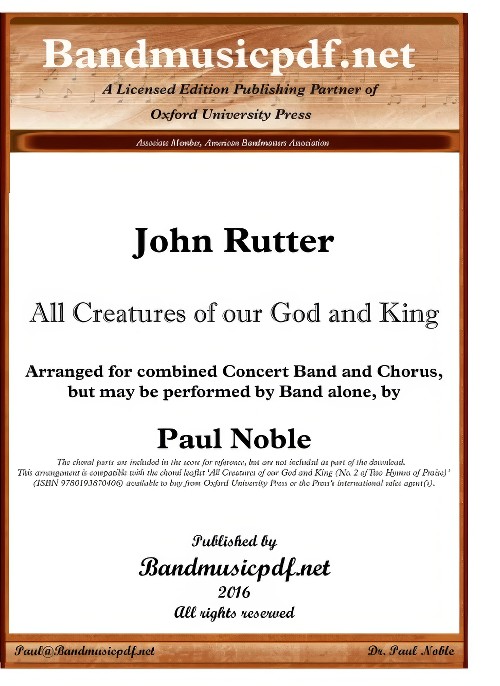 £110.00
£110.00All Creatures of our God and King (Concert Band with Optional Choir - Score and Parts) - Rutter, John - Noble, Paul
All Creatures of Our God and King is an English Christian Easter hymn by William Henry Draper, based on a poem by St. Francis of Assisi. It was first published in a hymn book in 1919. The words of the hymn were initially written by St. Francis of Assisi in 1225 in the Canticle of the Sun poem, which was based on Psalm 148. The words were translated into English by William Draper, who at the time was rector of a Church of England parish church at Adel near Leeds. Draper paraphrased the words of the Canticle and set them to music. It is not known when Draper first wrote the hymn but it was between 1899 and 1919. The hymn is currently used in 179 different hymn books. The words written by St Francis are some of the oldest used in hymns after Father We Praise Thee, written in 580 AD. Like Ye Watchers and Ye Holy Ones, Draper's text is usually set to the tune of Lasst uns erfreuen, a German Easter hymn published by Friedrich Spee in 1623 in his book Auserlesene Catholische Geistliche Kirchengesng. This tune became widespread in English hymn books starting with a 1906 arrangement by Ralph Vaughan Williams. John Rutter also wrote a piece of music for the hymn. Despite the hymn being initially written by Draper for Whitsun (the Anglican and English designation for Pentecost), it is mostly used in the ealier weeks of the Easter season. This setting by John Rutter begins with a rousing fanfare for trumpets and trombone, which segues in to the first verse of the hymn. There are seven verses included, but the director has the option of deleting verses as desired.
Estimated dispatch 7-14 working days
-
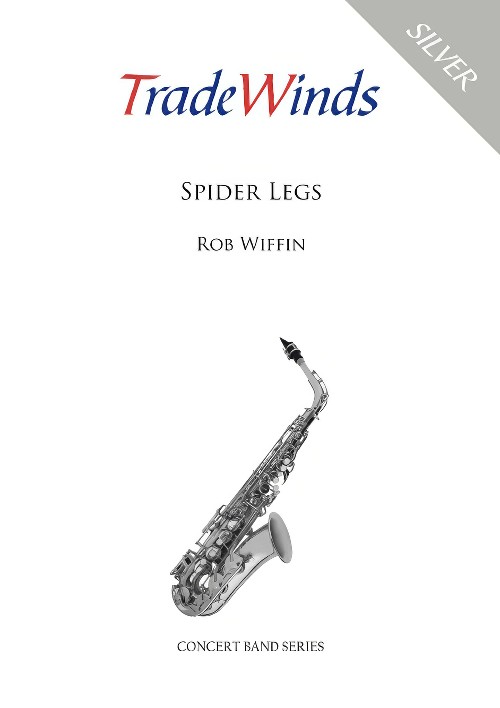 £54.95
£54.95Spider Legs (Concert Band - Score and Parts) - Wiffin, Rob
Spider Legs is a vibrant Latin dance number. Although I have used Latin rhythms in pieces in recent years this is the first time I have returned wholeheartedly to one of my favourite types of music since I wrote Tiptoe Tune in 2001. Typically I wrote it when I should have been writing something else but I really enjoyed going back to these rhythms. Stylistically Spider Legs can best be described I suppose as 'Merengue House' but perhaps it is better without any description! It was composed in 2014, shortly after the birth of my granddaughter Emma Louisa who was nicknamed 'Spider Legs' at the time and the name seemed to fit the music so well that I could not resist it.
Estimated dispatch 7-14 working days
-
 £10.95
£10.95Spider Legs (Concert Band - Score Only) - Wiffin, Rob
Spider Legs is a vibrant Latin dance number. Although I have used Latin rhythms in pieces in recent years this is the first time I have returned wholeheartedly to one of my favourite types of music since I wrote Tiptoe Tune in 2001. Typically I wrote it when I should have been writing something else but I really enjoyed going back to these rhythms. Stylistically Spider Legs can best be described I suppose as 'Merengue House' but perhaps it is better without any description! It was composed in 2014, shortly after the birth of my granddaughter Emma Louisa who was nicknamed 'Spider Legs' at the time and the name seemed to fit the music so well that I could not resist it.
Estimated dispatch 7-14 working days
-
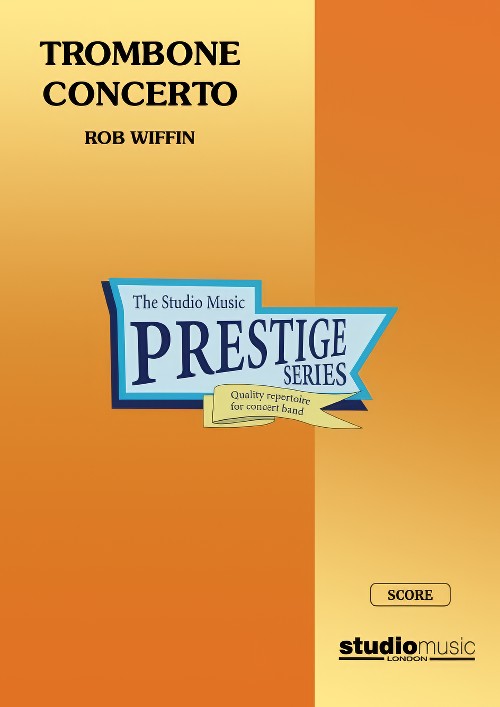 £32.95
£32.95Trombone Concerto (Trombone Solo with Concert Band - Score only) - Wiffin, Rob
The composer writes:My Trombone Concerto was commissioned by Brett Baker following an earlier piece I had written for him called Shout. The concerto was composed in Spain the summer of 2010. Once I started writing I realised this concerto was, inevitably, going to draw on my own experiences as a trombone player.The first movement was really a matter of getting the right thematic ideas and balancing the tutti and solo passages so, for formal structure, I studied the Gordon Jacob Trombone Concerto. There is a lyrical section preceding the first Allegro that owes much in spirit (but not the actual music) to The Eternal Quest, Ray Steadman-Allen's Salvation Army solo.The slow movement seemed determined to come out in the vein of a Richard Strauss song. I wanted to write ineluctably cantabile as we trombone players rarely get a chance to play the melody! There is a brief allusion to that wonderful moment when the trombone gets to sing above the orchestra in Sibelius' seventh symphony. Arthur Wilson (my teacher at college) died in the summer of 2010 so it seemed appropriate to dedicate this movement to him.The last movement is the lightest of the three in style and is slightly jazz-inflected, hopefully providing some fun for the soloist.While wanting to test the instrument, I did not set out with the intention of making the concerto difficult but there are undoubtedly challenges of technique, range and style to be met by the soloist.Recorded on Polyphonic CD QPRM161D Roman TrilogyDuration: 19:30
Estimated dispatch 7-14 working days
-
 £164.95
£164.95Trombone Concerto (Trombone Solo with Concert Band - Score and Parts) - Wiffin, Rob
The composer writes:My Trombone Concerto was commissioned by Brett Baker following an earlier piece I had written for him called Shout. The concerto was composed in Spain the summer of 2010. Once I started writing I realised this concerto was, inevitably, going to draw on my own experiences as a trombone player.The first movement was really a matter of getting the right thematic ideas and balancing the tutti and solo passages so, for formal structure, I studied the Gordon Jacob Trombone Concerto. There is a lyrical section preceding the first Allegro that owes much in spirit (but not the actual music) to The Eternal Quest, Ray Steadman-Allen's Salvation Army solo.The slow movement seemed determined to come out in the vein of a Richard Strauss song. I wanted to write ineluctably cantabile as we trombone players rarely get a chance to play the melody! There is a brief allusion to that wonderful moment when the trombone gets to sing above the orchestra in Sibelius' seventh symphony. Arthur Wilson (my teacher at college) died in the summer of 2010 so it seemed appropriate to dedicate this movement to him.The last movement is the lightest of the three in style and is slightly jazz-inflected, hopefully providing some fun for the soloist.While wanting to test the instrument, I did not set out with the intention of making the concerto difficult but there are undoubtedly challenges of technique, range and style to be met by the soloist.Recorded on Polyphonic CD QPRM161D Roman TrilogyDuration: 19:30
Estimated dispatch 7-14 working days
-
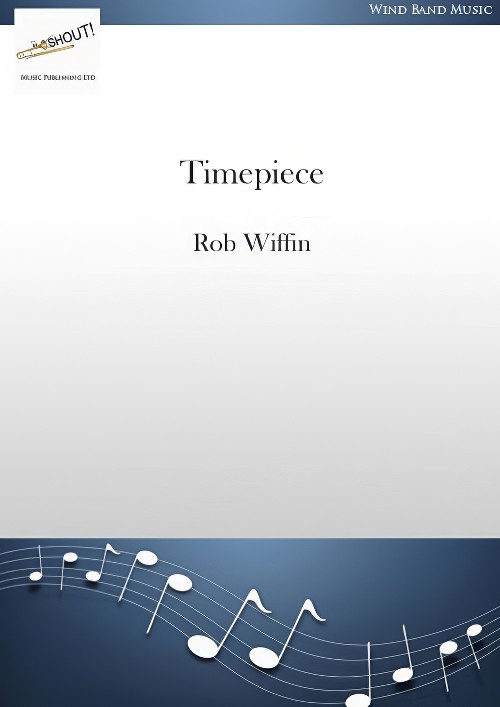 £79.95
£79.95Timepiece (Concert Band - Score and Parts) - Wiffin, Rob
Timepiece is a challenging work full of driving rhythms and relentless energy. It started life as the first movement of The Sands of Time, a commissioned work for clarinet choir. Because of the time limits of the commission, Wiffin could not develop the material as much as he had wanted to. He rescored it for wind band and included it as the first movement of a suite, but it did not sit well there because of its difficulty. Now re-worked and extended, the driving rhythms and many changes of time that give the piece its name are now balanced by a quieter, tranquil central section in 3/4. It is not easy, but most of the difficulty lies in the reading of the music rather than in any particular technical problems. It is recorded on on the RAF CD, Music in the Air.Duration: 6.15
Estimated dispatch 7-14 working days
-
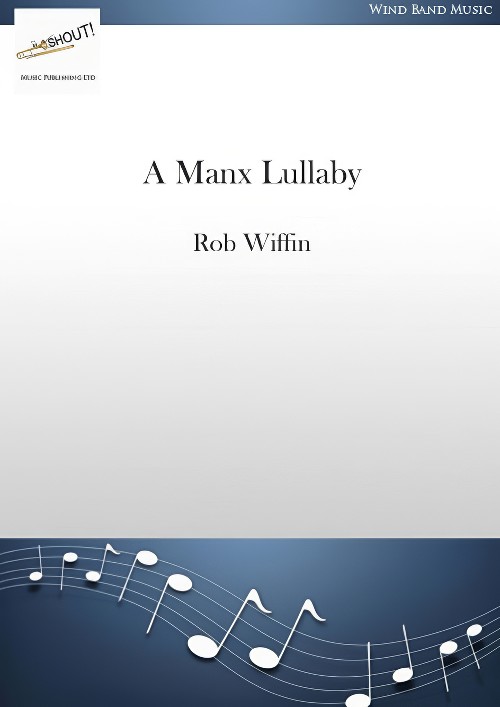 £36.95
£36.95A Manx Lullaby (Concert Band - Score and Parts) - Wiffin, Rob
A quiet, gentle piece dedicated to the Isle of Man Wind Orchestra. In February 2014 Rob Wiffin went to the Isle of Man to conduct a workshop with the Isle of Man Wind Orchestra. The year is particularly significant - Island of Culture 2014 is the largest cultural celebration in the history of the Isle of Man. This simple lullaby does not contain any traditional Manx material but was written specifically for the wind orchestra. It is in familiar ABA form but the middle section adds just a moment of piquancy and tension before the return of the original theme dissipates it.Duration: 3.12
Estimated dispatch 7-14 working days
-
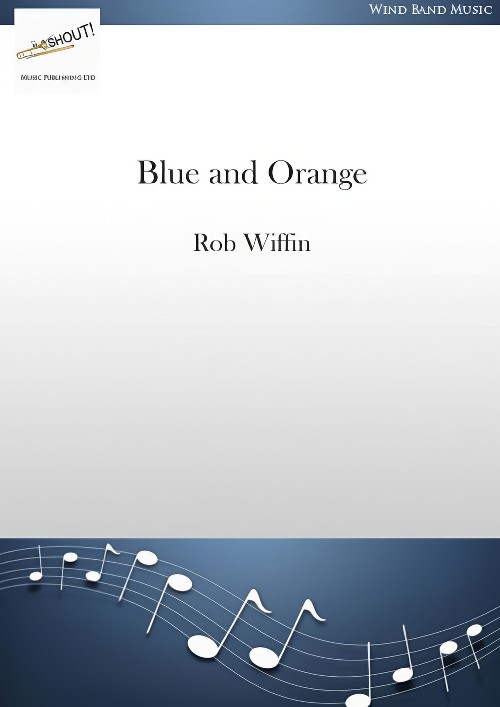 £72.00
£72.00Blue and Orange (Flute Solo with Concert Band - Score and Parts) - Wiffin, Rob
A song and dance for flute with wind band accompaniment. Blue is a gentle, tuneful solo. The accompaniment is very much in a chamber-music style and there are very few places where the whole ensemble plays at the same time. There is nothing overt or dramatic in the music and subtlety and rubato are very much the required manner. It is not a desperately sad piece but is just tinged with a little melancholy. Orange on the other hand is a fiery, driving dance which gives the soloist a chance to display technical prowess. During the outer sections Latin percussion carries the music along but the inner sections are more dissonant and are built on inner rhythm. The two pieces are as contrasting as possible, just like the colours of the title.Duration: 3.15 & 4.15
Estimated dispatch 7-14 working days
-
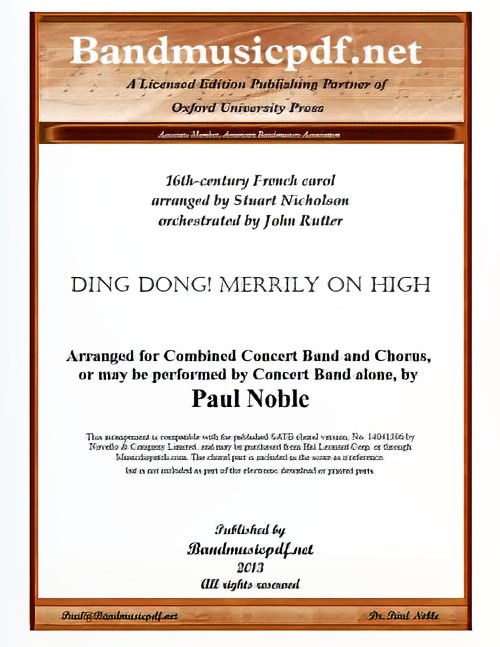 £75.00
£75.00Ding Dong! Merrily on High (Concert Band with Optional Choir - Score and Parts) - Noble & Rutter
Since first hearing John Rutter's orchestration of Stuart Nicholson's adaptation of this piece, I have wanted to bring it to the repertoire of the Concert/Wind Band. It is written for combined Concert Band and Chorus, but may be performed by Band alone. The choral part is shown in the conductor's score, but is not included in the set. This is the happiest and most joyful presentation of the 16th-century French carol that will delight your audience and band alike!
Estimated dispatch 7-14 working days
